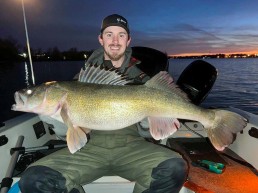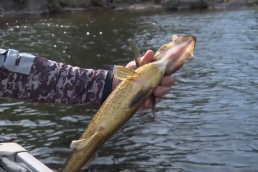The Walleye Menu Comes with a Choice of Sides
SHARE THIS POST
In May, which is walleye spawning time throughout much of the North Country, walleyes could be pre-, post- or smack dab within the spawn. In most cases, they’re going to be somewhat shallow. Also in most cases—particularly with clear water, bright skies and or calm conditions—they may be spooky in the shallows. That typically requires getting your lures or baits well out to the sides of the boat—casting, drifting or trolling—to minimize spooking them with the boat’s presence or passage.
Here are some suggestions to choose the proper “asides” for walleyes in different conditions:

Walleyes on the inside: When it’s calm, try pitching to shoreline rocks or downed timber using 1/8-ounce jigs dressed with a minnow or plastic for stealth. Lift-drop or swim them back to the boat. When it’s windy, it may be easier to throw shallow minnow imitators or vibrating crankbaits like Rippin’Raps, especially when fish are less spooky.
…on the shallow side: Longline trolling a shallow-running imitator like a Husky Jerk about 75 feet behind the boat effectively triggers shallow biters. Give the rod tip an occasional pump-and-pause to help trigger strikes. Weave your way in s-shaped patterns to cover wider swaths of depth. Note where and how deep fish are caught: sand, rock, weeds, depressions, rises, etc. Something is likely concentrating them.
…on the dark side: When walleyes are shallow along shore, it may be easier to cast shall minnow imitators from shore at night, or when wading, than it is to cast inshore from a boat. Shorelines that drop quickly into 4 feet of water draw fish in closer than those with shallow, sloping beaches. Incoming current flows draw fish as well.
…on the upside: Anchoring and drifting a slip bobber baited with a live leech or minnow is deadly above shallow reef tops, particularly with some wind. Anchor upwind, set your bobber to dangle your jig or hook/sinker combo just above the tops of the rocks, cast out and let the float drift downwind, across the rocks. At night, use a lighted bobber. You can also pitch slip bobbers to the edges of downed timber or submerged wood in flowages and rivers.
…on the downside: Where vertical cover like weeds or wood is lacking, trying fishing any of the systems mentioned here closer to or along the bottom, without snagging in rocks, sandgrass or other debris. However, walleyes aren’t bass. You don’t need to “bump the stump” to catch them when they’re shallow. Mid-depth to near-bottom retrieves work equally well.
…from the front side: This is where forward live viewing comes into play. Work your way across shallow flats using your trolling motor, scanning for the presence of fish while casting, drifting or trolling.
Are you enjoying this post?
You can be among the first to get the latest info on where to go, what to use and how to use it!
…off the backside: Snapjigging a jig on a long line behind the boat can be deadly for triggering strikes when walleyes are on flats. Use a slightly heavier jig—like 1/4-ounce—dressed with a plastic minnow imitation. Impart pronounced forward wrist snaps to the rod tip, followed by dropping the tip straight back toward the lure, to make the jig shoot forward and up, followed by dropping down to or near bottom.
…off one or both side(s): Drifting flats is popular on large, windswept lakes where walleyes actively feed in the shallows. Longline 1/4-ounce-jigs dressed with minnows or plastic tails. Use sea anchors to slow your drifts if necessary. Also, if simply fishing along with your electric trolling motor and fancasting jigs or cranks, side imaging reveals fish and the bottom content or cover that attracts them.
…on the topside: If you need to troll over the tops of shallow weeds or submerged wood without snagging, try longlining a small-bladed spinner harness rigged with a nightcrawler or soft plastic minnow or ’crawler just above the weed tops or wood cover. The flash and pulsation will get ‘em! Or fancast and slow-roll a shallow minnowbait that barely tickles the weed tops. Pause occasionally to trigger followers to strike.
…on the bottom side: In reservoirs, trolling bottom bouncers and spinner harnesses dressed with minnows or ‘crawlers excels for fishing shallow flats. The sinker crawls up and down slopes, trailing your bait a few inches to a foot above.
…on the outside: If nothing’s doing up along shorelines or atop shallow flats, shift your focus deeper, across mid-depth flats. Try to locate active biters on sand or rock flats, in developing weed growth, flooded wood cover, etc. Consider using planer boards to spread lines and lures to the sides of the boat to 1) reach out to walleyes that might be spooked aside by the boat’s approach, and 2) to cover more area than simply trolling off the back of the boat.
…on the deep side: If all your shallow experiments and gyrations fail, you may actually need to move out to the first drop-off to deep water and fish along the edge. Use traditional bottom-hugging techniques like livebait rigging with minnows or vertically jigging a jig & minnow or jig & soft plastic. Just don’t be in a hurry to do it without at least testing shallower water first, because at this time of year, that’s where the bulk of the walleyes are likely to be.
Take sides
When walleyes are shallow, you have a lot of options for catching them. Under the conditions, some could be good, mediocre or even outright unproductive. Evaluate the situation and choose the right “sides” accordingly. They may not be favorite methods or particularly suit your taste, but you’re not the one being encouraged to open your mouth, either. Do whatever it takes to catch fish.
The other side of the story…
A long, long time ago, two brothers and some friends fished all night without success. When they pulled ashore empty-handed and dejected at daybreak, a previous acquaintance of one brother encouraged them to have faith and make one more cast off the other side of the boat. They filled the net! Which proves that there’s always another side to a good fish story.
All kidding aside!
MWO
SHARE THIS POST
Did you enjoy this post?
You can be among the first to get the latest info on where to go, what to use and how to use it!
Dave Csanda
Dave Csanda has enjoyed 40 years in the fishing communications industry at In-Fisherman, Angling Edge and now, as editor of MidWest Outdoors. He is an inductee of both the Minnesota and National Fresh Water Fishing Halls of Fame.



